Two-Day Training Content
If you teach the Communication Module as part of a 2-day training, you should be able to perform all the activities noted below in around 80 minutes.
Components to include in this section for a 2-day training include:
- Introduction and Objectives: 5 minutes
- Communication Exercise: 7 minutes
- Communication Meaning and Importance: 7 minutes
- Information Exchange Tools
- Introduction and SBAR: 8 minutes
- SBAR Video and Exercise: 7 minutes
- Call-Out: 3 minutes
- Check-Back: 3 minutes
- Handoff Introduction and Discussion: 5 minutes
- I-PASS: 5 minutes
- Other Handoff Tools: 2 minutes
- Tool Exercise: 15 minutes
- Summary: 3 minutes
- Applying TeamSTEPPS Exercise: 5 minutes
Teaching Goals
It's important to continuously reinforce your enthusiasm for TeamSTEPPS and its importance to patients and healthcare workers. You also should continue to foster mutual respect, fun, and transparency through the use of active learning and listening throughout the section. Specific objectives for this section include:
- Describe how communication affects team processes and outcomes.
- Define effective communication.
- Identify communication challenges.
- Identify TeamSTEPPS tools and strategies that can improve a team’s communication.
Teaching Process
Introduction and Objectives
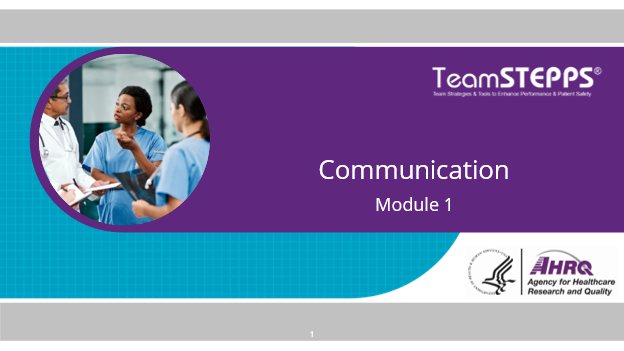
Referring to Slide 1, “Communication,” note that you're now transitioning into the first of TeamSTEPPS's learnable and teachable skills. Explain that the Communication Module comes first because all the other modules require a basic understanding of communication and its value.
Start the module by asking for a show of hands of how many participants think most of the people they work with are really effective communicators. Then ask how many participants think most of the people they work with are really effective listeners. Call attention to the fact that the assessments of communication and listening were different for different people; raise the question whether it’s possible to be an effective communicator without being a good listener (or vice versa). Explain that you’ll revisit this question at the end of the module.
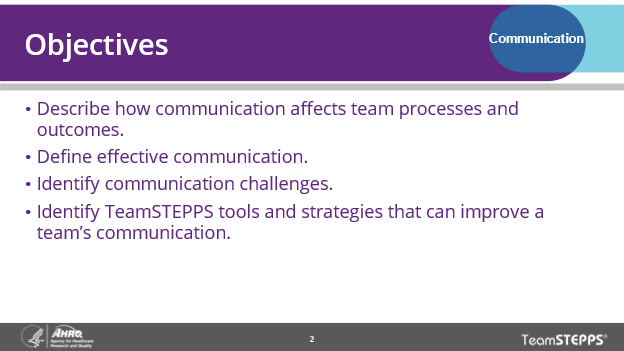
Referring to Slide 2, "Objectives," review the objectives for the Communication Module; save time by displaying the slide without orally reviewing each objective. Stress the broad goal of acquiring insights and tools that will enable their teams to communicate more effectively with each other, including patients and family caregivers. Objectives include:
- Describe how communication affects team processes and outcomes.
- Define effective communication.
- Identify communication challenges.
- Identify TeamSTEPPS tools and strategies that can improve a team's communication.
Communication Exercise
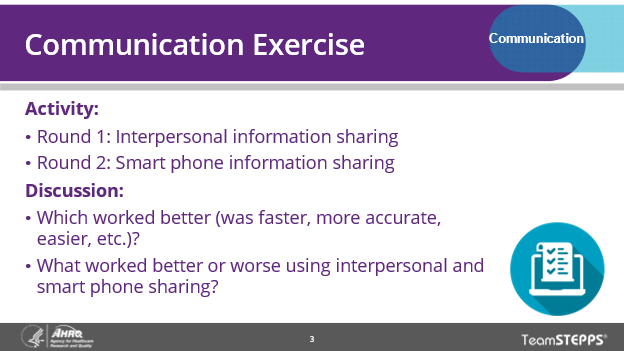
Referring to Slide 3, “Communication Exercise,” break the class into small groups with four to six participants. Ideally, each group will have the same number of participants. Explain that the goal is to convey an assigned message as accurately and quickly as possible from the first person to the last and that the first round will be sharing the messages verbally from one person to the next. Give the groups a chance to organize themselves and set their order. It may be best for people to stand in a line to make it harder for people to overhear. If some groups have more people, have each group keep track of the time required to communicate the message to the fourth person, if that’s the size of the smallest group. Explain that they’re allowed to repeat the message only once when sharing it with the next person. You can make up your own message or use the following:
- Robert Green said that his left ankle was feeling better, but his right knee started feeling sore Saturday.
Ask each group to complete the exercise as quickly and accurately as they can. Then compare times and levels of distortion across the groups. If your class has virtual groups, have each group member turn off their sound until it’s their turn, which they can be informed of using the chat feature in your platform.
Repeat this process again for Round 2 using smart phones. Give time for each person to have the phone number or email address of the person they will send the message to. If someone doesn’t have a phone or laptop or is uncomfortable sharing contact information, provide cards for them to write their messages on.
Repeat the process using a message you create or the following one:
- Pete Thomas can't work this Thursday, but Tom Peterson can work on Tuesday if Susan can't.
Have each group complete the exercise as quickly and accurately as they can. Then compare times and levels of distortion across the groups. If your class has virtual groups, have them use the chat feature and direct their message only to the person that’s next in line in their group.
When you’ve done the two rounds (or just one round if time is short), ask the group to discuss which worked better and what made the two approaches harder or easier. Conclude the discussion by noting that communication seems simple but is also challenging. That’s why better understanding it and having tools to perform communication tasks efficiently is important.
Communication Meaning and Importance
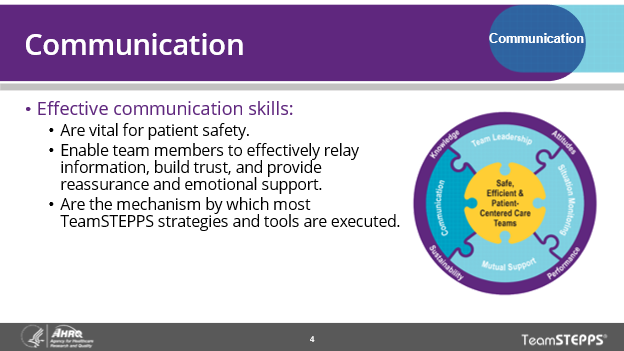
Referring to Slide 4, “Communication,” remind the class of the importance of communication and its interconnections with the other three TeamSTEPPS skills and that all are needed to deliver safe, efficient, and patient-centered care.
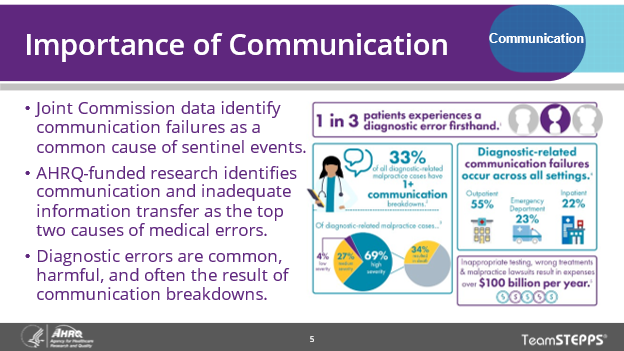
As you display Slide 5, “Importance of Communication,” note that communication is a core cause of many medical errors. You may want to note the separate TeamSTEPPS for Diagnosis Improvement resource that is available on the TeamSTEPPS website. Ask the class to share an example from their own experience of how a communication failure put a patient at risk and how effective communication caught an error before it occurred. If time permits, ask about effective communication, to keep the training’s focus positive.
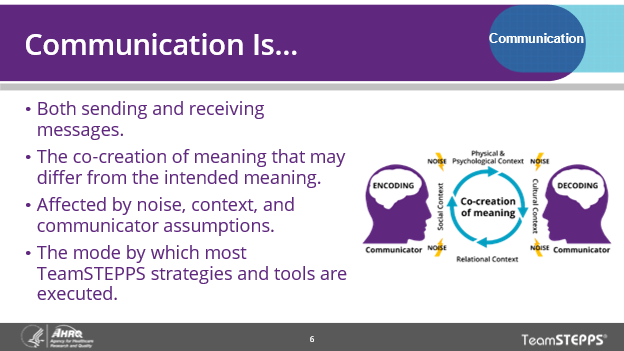
As you introduce Slide 6, “Communication Is...,” provide a concise overview of the Communication Module. Key points to emphasize:
- Both message senders and recipients are communicating—speaking and listening are both core communication processes and both are active roles.
- In all communication exchanges, everyone is both sending and receiving messages through the messages and feedback they share verbally and nonverbally.
- The understood meanings of messages can be different from the intended meanings because of the context, backgrounds, and psychological states of those involved. What people mean to say may not necessarily be what others understand. Ask whether anyone has an amusing example of a misunderstanding of a message from their personal experience. Examples: showing up at the wrong place or time to a party, or confusing which person a friend told you was going on vacation and which was having surgery.
Note that how different people communicate can vary a lot; younger people may speak more informally and use text messaging abbreviations that older generations may not understand.
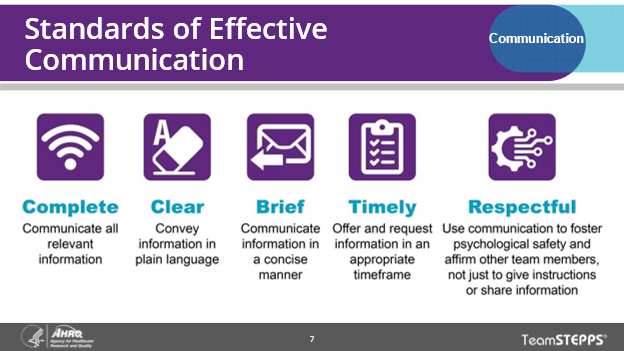
Regardless of such differences, healthcare requires communication that meets the five criteria on Slide 7, “Standards of Effective Communication.”
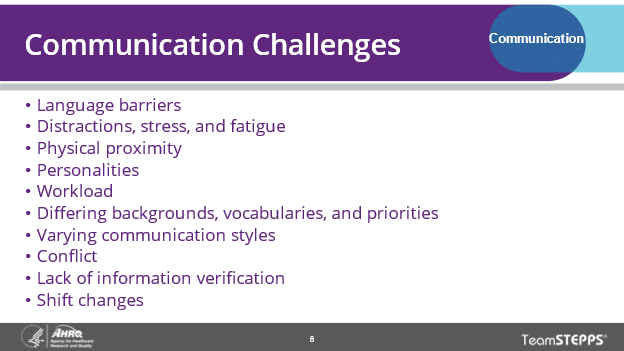
Before you introduce Slide 8, “Communication Challenges,” have your class’s small groups take 2 minutes to list as many communication challenges as they can. Then, display the slide and ask the class which of the standards on Slide 8 isn’t met the most often and why. Encourage them to self-evaluate their own communication and pick one area in which they’ll consciously work to improve over the next month.
Information Exchange Tools
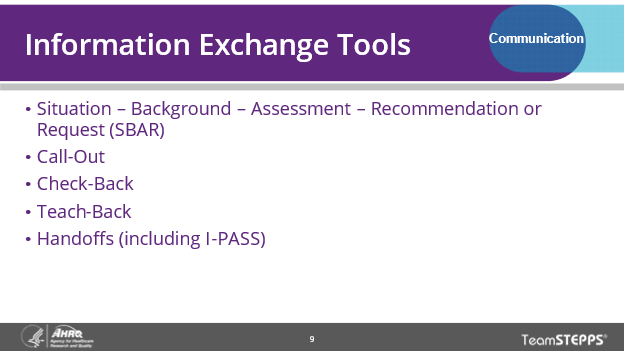
Introduce Slide 9, “Information Exchange Tools,” noting that many types of communication encounters are important to the well-being of patients and teams. TeamSTEPPS includes tools to manage communication in an effective way. Since TeamSTEPPS includes many tools, explain that the goal for this training isn’t to get everyone to start using 20 new tools tomorrow. Instead, this training creates awareness of them so everyone may pick a number of tools that will help them address challenges on their teams. Over time, they may choose to use more tools. The TeamSTEPPS app and website provide additional information and examples of all the tools they can use to address emerging challenges.
Introduction and SBAR
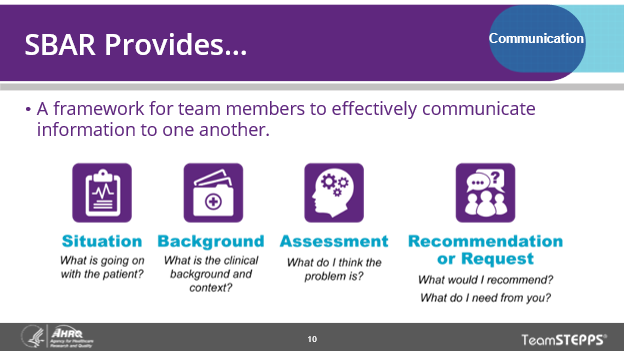
Introduce Slide 10, “SBAR Provides,” and ask trainees how many of them are already familiar with SBAR. If almost all are, shorten the discussion of this section but note that it’s a useful tool for summarizing all sorts of information and can be used to discuss patient care, other workplace improvements, or even changes you’d like to discuss with family members or others. The key benefits of SBAR are:
- It provides a useful organizing framework that requires focus on key information in a logical sequence.
- It keeps the focus on the issue, versus feelings, views of others, or information that isn’t relevant to the final recommendation or request.
SBAR Video and Exercise
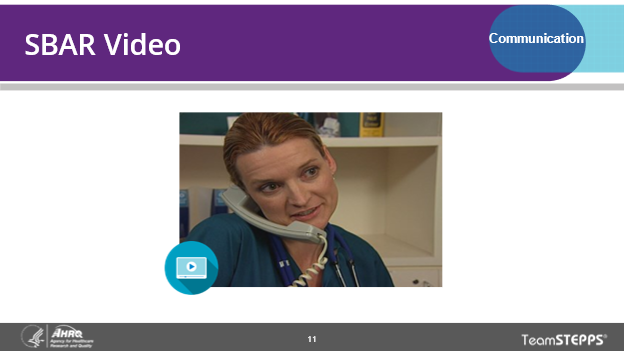
Introduce Slide 11, “SBAR Video.” If your class isn’t familiar with SBAR, you can play this video and ask the class to react to it. Alternatively, use the patient story or other video clips that are referenced in section 2 of the Communication Module.
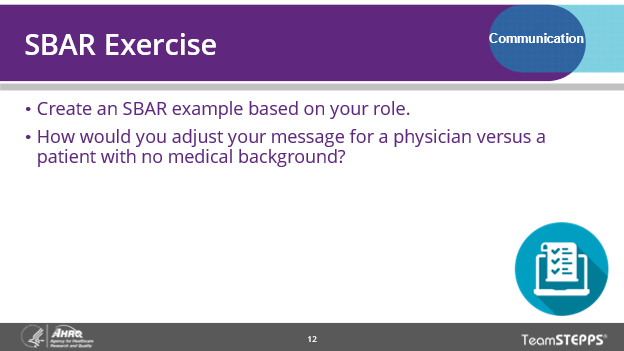
To further reinforce the usefulness of SBAR, use Slide 12, “SBAR Exercise.” Have small groups develop SBAR scenarios that relate to common work experiences. Have a few groups report out their examples to the class. Alternatively, provide a hypothetical to the class and have them talk through what each step should include. As they do so, reinforce the need to make each step as clear and succinct as possible. If the recipient needs additional information, they can ask for it along the way or after hearing your recommendation.
Call-Out
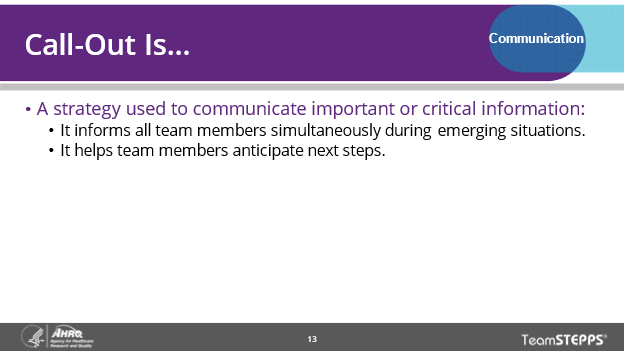
For Slide 13, “Call-Out is,” provide a brief explanation of call-outs and note their value in situations involving multiple team members reacting to a time-sensitive situation. You may want to use either a long-term care video or a labor and delivery video illustrating a call-out.
Long-Term Care Video
TeamsSTEPPS: Call-Outs in Labor & Delivery (18 seconds)
Labor and Delivery Video Illustrating a Call-Out
TeamSTEPPS: Call Out (Subacute Care) (27 seconds)
Ask whether any participant uses call-outs in their organization and ask them to share an example and explain whether the call-out was helpful.
Check-Back
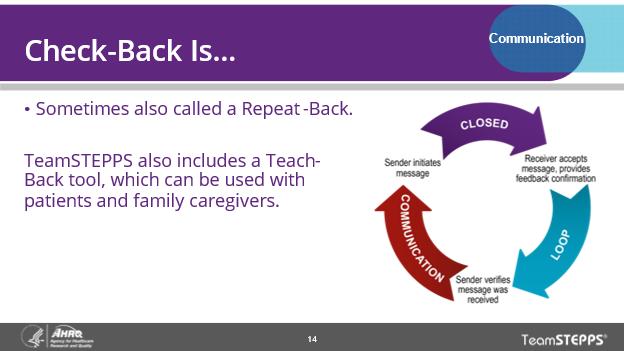
For Slide 14, “Check-Back is,” introduce check-backs as a communication tool designed to ensure that messages were attended to and understood as their source intended. Ask for a volunteer to share an example from their own experience of how a message wasn’t attended to or correctly understood. Examples from everyday experience (e.g., not really listening when your spouse tells you that you need to pick up a child after school or misunderstanding the time or location where the child will be) can show the broad usefulness to everyday life and keep the training from becoming too focused on stories about harm to patients. After briefly explaining the three phases of a check-back loop, you may want to encourage participants to test out check-backs in everyday life to get practice and make them easier to apply successfully at work.
If supporting patients with limited English proficiency is common among participants, you may want to illustrate their use in this context with the following video clip:
TeamSTEPPS: Limited English Proficiency Safety: Success (6:09)
Handoff Introduction and Discussion
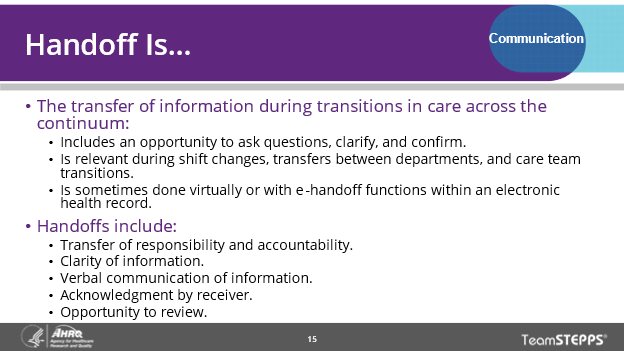
Before you introduce Slide 15, “Handoff is,” ask your class what the busiest and most stressful parts of their workday are. Some may list the start or end of their days when they are assuming responsibility for new patients or transitioning the responsibility to others. Use this feeling as the reason handoff tools are important. Pick several bullets (not necessary to cover all) that are most relevant to the trainees. Potential focuses include:
- Noting that handoffs involve transitions both between staff within a unit and between care settings. The former is typically done face to face, while the latter is often done virtually or through the transfer of documentation.
- Noting the emergence of e-handoffs. If many in the class are beginning to use these, taking time to briefly discuss their pros and cons may be worthwhile.
- Noting that clarifying exactly when responsibility and authority for the patient will change is important and often overlooked. You may ask the class to share a time when confusion over the transfer created inefficiencies or risks for the patient.
- Note that clear handoffs can reduce stress and worry associated with uncertainties about whether responsibilities for the patient were clear and being assumed by the handoff recipient.
I-PASS
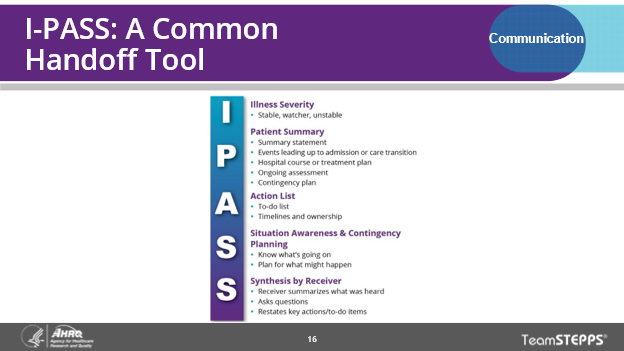
For Slide 16, "I-PASS: A Common Handoff Tool," introduce I-PASS as the preferred standardized handoff tool in many organizations because it is linked to proven reductions in errors and patient harms. Talk through the acronym and then ask a volunteer from the class to use it to hand off a patient recovering from a colonoscopy to the family caregiver who will take them home and keep an eye on them. Use the example to reinforce how to use I-PASS and that it can be used with patients and their families as well as with other team members.
Other Handoff Tools
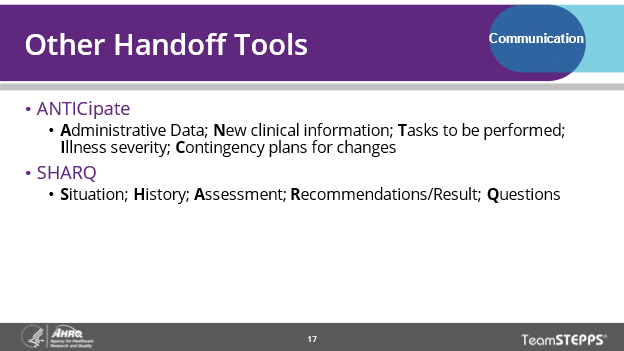
Introduce Slide 17, "Other Handoff Tools"; if participants use other handoff tools, including ANTICipate and SHARQ, acknowledge them and make the point that fewer tools used more consistently is better than too many tools that are infrequently used.
Summary
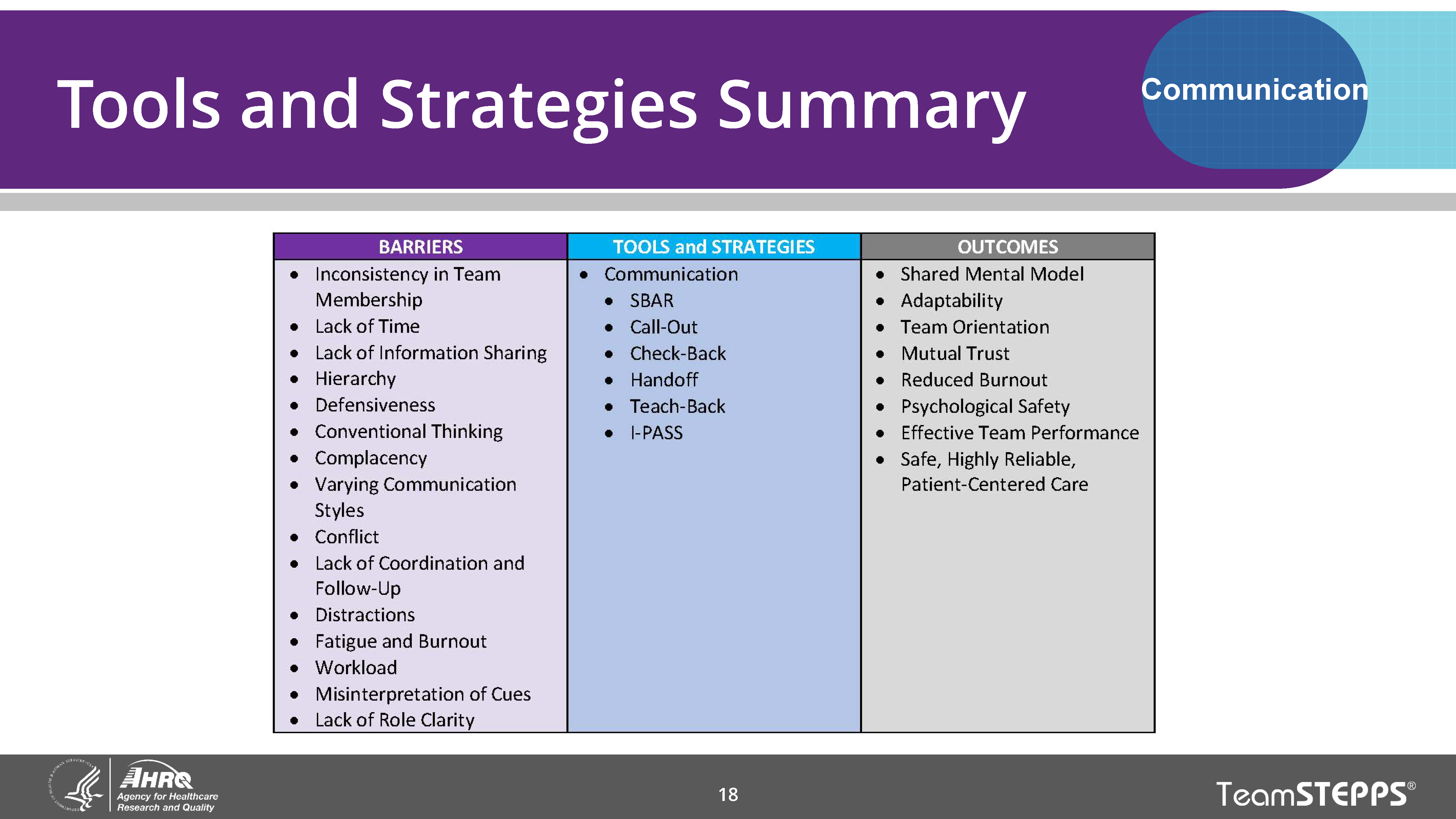
When displaying Slide 18, "Tools and Strategies Summary," note that participants have just learned a number of important communication tools that can help them work more effectively in their teams. All these tools help overcome the barriers and achieve the desired outcomes.
If you have time, ask the class which communication tool you've just discussed that they are most eager to use. Encouraging participants to publicly identify a tool they intend to try will increase the likelihood that they begin to use it in their work.
Applying TeamSTEPPS Exercise
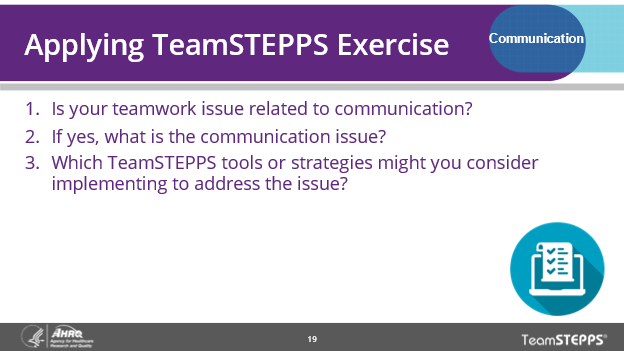
For Slide 19, "Applying TeamSTEPPS Exercise," if two or more people from the same organization or unit are attending the training and have introduced the Implementation Worksheet, you can finish the discussion of communication by asking the groups to return to the Worksheet and answer the questions related to communication as they relate to the teamwork issue they are trying to address.



